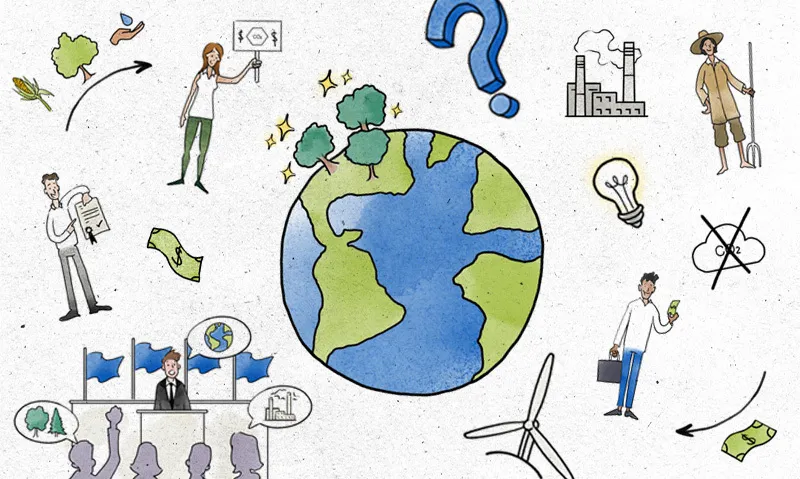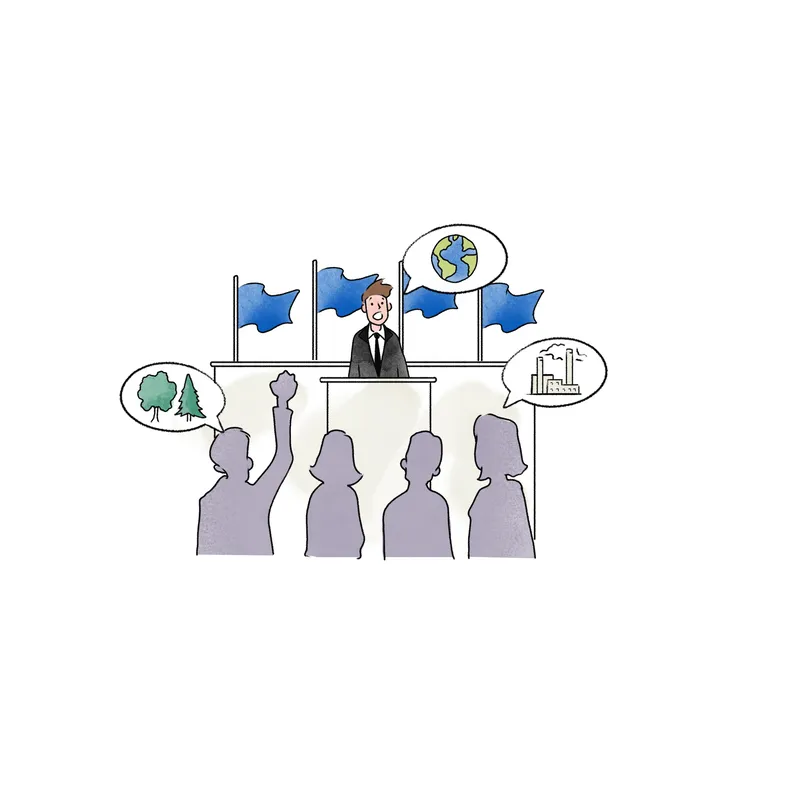Small (illustrated) guide to understanding the voluntary carbon market



The Industrial Revolution changed our planet in an infinite number of ways; on the one hand, the relationship with nature became merely utilitarian and commercial, and on the other, the global climate changed year after year until it brought us to this point -almost- of inflection in which we are currently experiencing the climate crisis. One of several answers to this problem comes from carbon markets, both regulated, which are governed by regulations, and voluntary ones, which offer a wider range of opportunities to achieve our climate goals. We will talk about the latter today: how are they created, what are they, how should we understand them, are they functional? These are just a few questions that we may take for granted, however, they mark the way in which we conceive and with which we face the existing crisis, so it is important to be very clear about the implications and scope of this instrument.
How did it all start?
The eighties marked an international milestone because we formally stated that there was an enormous problem with our planet; a problem for which we were responsible. The climate became the center of attention. Over the next two decades, panels, conventions and agreements were created to effectively address the so-called “climate crisis”. Two of these tools (specifically) gave rise to the carbon market as we know it today: the Kyoto Protocol (1997) and the Paris Agreement (2015).
On the one hand, this first put into practice what was discussed in the United Nations Framework Convention on Climate Change, stressing that certain countries, due to obligations and development resulting from historic debt, should imminently reduce their carbon footprint. This is how a regulated and mandatory carbon market emerges. On the other hand, as a result of recognizing that the Kyoto Protocol (KP) was not enough, the Paris Agreement emerges, which encourages countries and companies that did not have an obligation, that is, a legally binding commitment as established by the KP but a will to reduce their emissions, to have a way of developing climate action projects; broadly speaking, this is how the voluntary carbon market.

What is the voluntary carbon market?
Let's start by saying that what carbon markets, both regulated and voluntary, do is to convert CO2 emissions into an interchangeable commodity by giving them a price, usually in the form of credits, Offsets or carbon credits that have been prevented or removed from the atmosphere.
In carbon markets regulated companies and governments are involved that are obliged to compensate for the greenhouse gas emissions they generate as a result of their activities. In the vast majority of their cases, they are governed by governmental or even intergovernmental regulation. In this form of market, the carbon credits, since they work as a “permit” to emit GHGs in the present and in the future. You may as a company use the carbon credits that are granted to you, or you may not use them (because you reduced emissions through technological innovations in your operation) and then you have plenty of them, so you have the option of trading them with other companies that don't have enough, however, the directionality of these “permits” flows between a regulatory government entity and the company in question.
Voluntary carbon markets are somewhat similar, but very different in execution. They respond to the desire of many companies and individuals to offset their carbon emissions because they want to. There is nothing mandatory, it's pure conscience or desire to make your corporations more socially and environmentally responsible. And it should be noted that the voluntary market, representing the initiative of private entities, It is a fundamental piece that complements the regulated market. Without voluntary commitments and mechanisms to facilitate their implementation, there will be no major breakthrough in the climate landscape. This can be achieved through different ways, but under the same principle of avoiding, reducing or mitigating greenhouse gas emissions and verifying what has been achieved through carbon credits, which can be generated in several ways. One of the ways that seem most far-reaching to us are forest carbon projects or those that involve nature-based solutions (since there are renewable energy and energy efficiency projects as well), since they also involve a social component and environmental, beyond a climatic one.

Who makes it up?
The voluntary carbon market is moderated by organizations that are responsible for verifying the integrity of the carbon credits generated. It results in a horizontal movement of services and products between companies. On the one hand, we have those we call 1. Project developers, either of forest carbon, from regenerative agriculture or any other existing modality, those who produce the bonds; likewise, we have 2. Certifiers and verifiers, who are responsible for ensuring that the integrity and quality of the project effectively meets the necessary standards; then there are 3. Brokers, Who makes the transaction Per se between companies; and finally, the 4. End customer, who will use the bonds to affirm their contribution to climate action as part of a climate strategy.
It is very important to mention that this is the general scheme, however, in many countries, especially in the global south, territorial climate action is possible due to the existence of a Social tenure of lands, that is, a group of people who have ownership and governance over their territories, so ideally, the basic actors of these projects are Owners of the Earth, who play the main role so that quality climate action can happen in the first instance.

The advantage Voluntary
For those who do not have any legally binding commitment according to the KP or for those companies that are in countries that do not yet have their own Emissions Trading System, that is, they can only depend on the voluntary carbon market, investing in it is an enormous opportunity because to do so is to go beyond what is already established: it is betting on a future for your organization or company; adding to reducing your socio-environmental footprint, not just climate; mitigating historical emissions, not just future ones; really moving towards the objective of carbon neutrality by 2050; strengthening the company's reputation before society, and entering new sources of income that are based on rebuilding the planet instead of degrading it.
With the above, we do not mean that the voluntary carbon market is only for those who exclude themselves from legal or national obligations, the voluntary market is for everyone, because If your company is already under a regulated and mandatory system that encourages it to reduce emissions, voluntary trade can mitigate those that are impossible to reduce. Let's face it, just sticking to your country's Emissions Trading System or some mandatory legislation isn't really doing our best for the planet, it's simply doing the “necessary minimum”, a relative minimum that's not enough to avoid catastrophic global warming scenarios.

Does it work as we expect?
No, the voluntary carbon market does not work as we would like, and this is due to several reasons: on the one hand, it is a growing market and still faces many challenges, and on the other hand, what we have already established does not work quite well, there are many opportunities.
Problems such as the implementation of some concepts -such as additionality, permanence, transparency and traceability- have meant that many carbon credits from forestry projects or nature-based solutions are of very low quality and integrity, which rarely take that basic actor that we mentioned earlier, that is, the owners of the land, into consideration and fair remuneration for their work. What should we continue to focus our efforts on? On building a fair and transparent carbon market. Because it is not regulated by governmental or international checks, we must be the ones who actively participate in this market, who strive for the highest possible quality standards. There is no cheap or simple climate action, we are talking about regenerating our planet. It cannot be done without intersectoriality, without revaluation of land owners, without regenerative supply chains, without adequate funding, without fair compensation, without social and environmental safeguards, and without conscience.

How do you participate in the voluntary market?
One thing we should know is whether you are an individual or a company, the voluntary carbon market responds to your climate awareness, however, for this case, let's see what it can do for you if you are a corporation. The first step will always be to know how much you pollute. What specific gases; why; what link in your supply chain they come from; are your majority Scope 1, 2 or 3 emissions; you have control over them or you don't. All of this and more is solved with an emissions inventory. So the first step is to know your carbon footprint. Then it is important to know what of the above we want to reduce and mitigate. For this, we must start by setting medium and long-term goals. Realistic goals that preferably solve problems at the root, in order to ensure that the change is happening from the ground up. The goals are accompanied by the design and execution of reduction and mitigation tools, within what we know as a climate strategy: we will always start by reducing what can be reduced, but we must be very aware that not everything is reduction. The carbon footprint will always exist and that is why we must mitigate as well. For the same reason, the voluntary carbon market offers both alternatives, we can have energy efficiency and renewable energies to reduce, and forest carbon projects or nature-based solutions to mitigate.
So how do you start participating in the voluntary carbon market? If you are an industry or a company that is already under an Emissions Trading System or a legal mandate, go further and learn about the advantage conferred by voluntary markets, write to us to learn more about it; but if on the other hand you have no legal obligation to reduce or mitigate your emissions, but you do have the willingness to change our world, too write to us. In both scenarios, we know how to help you.

Explore reflections, research and field learning from our work in ecosystem restoration.